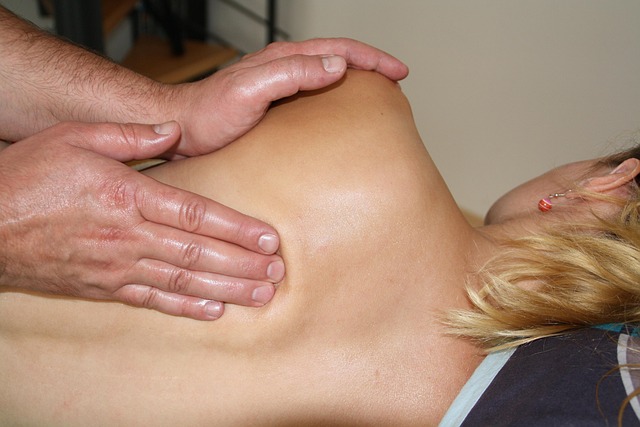Cold and heat therapy for muscle healing is a powerful, science-backed strategy used in sports medicine. By alternating between hot and cold treatments, athletes can reduce post-workout soreness, stiffness, and injury risk, while speeding up recovery and enhancing performance. This holistic approach optimizes blood flow, reduces inflammation, removes metabolic waste, and nourishes muscles for faster repair and regrowth.
“Discover the power of contrast therapy as a revolutionary approach to muscle recovery. This natural method combines cold and heat treatments, offering a unique solution to common post-workout aches and pains.
In this article, we explore the science behind these contrasting temperatures and their profound effects on muscle healing. From understanding the challenges of recovery to implementing effective contrast therapy routines, you’ll gain insights into a game-changing practice that can transform your fitness regimen.”
Understanding Muscle Recovery and Its Challenges
Muscle recovery is a complex process that involves repairing and regenerating damaged tissue after physical activity or injury. While rest and proper nutrition are crucial, muscles often require additional support to heal efficiently. The challenges lie in managing inflammation, reducing muscle soreness, and restoring strength without causing further damage or delays in recovery.
Contrast therapy, which alternates between cold and heat treatments, has emerged as a powerful tool in sports medicine. By incorporating cold and heat therapy for muscle healing, athletes and individuals can enhance blood flow, reduce inflammation, and promote faster recovery. Cold therapy helps constrict blood vessels, decreasing metabolic waste and swelling in the affected area. Heat therapy, on the other hand, increases circulation, relaxes muscles, and stimulates the release of endorphins, contributing to a more comfortable and accelerated recovery process.
Introduction to Contrast Therapy
Contrast therapy, a time-honored practice, has gained prominence in sports medicine due to its effectiveness in accelerating muscle recovery. This holistic approach leverages both cold and heat treatments to stimulate blood flow, reduce inflammation, and promote healing. By alternating between these extremes, athletes can experience faster relief from post-workout soreness, reduced muscle stiffness, and enhanced overall performance.
Cold and heat therapy for muscle healing works synergistically; cold applications, like ice baths or compression, constrict blood vessels initially, reducing swelling and pain. Heat treatments, such as saunas or hot showers, subsequently expand these vessels, increasing circulation and delivering essential nutrients to repair damaged tissue. This contrast is key, allowing the body to efficiently flush out metabolic waste while nourishing muscles with oxygen and key elements for regrowth.
The Science Behind Cold and Heat Therapy
Cold and heat therapy for muscle healing has gained significant traction in sports medicine due to its scientific backing. The science behind this method lies in its ability to modulate inflammation, a key process in muscle recovery. Cold therapy, typically through ice packs or cold baths, reduces blood flow to the affected area, minimizing swelling and pain. This is particularly beneficial during the acute stages of muscle injury, where rapid reduction in inflammation can prevent further damage.
On the other hand, heat therapy promotes blood circulation, which aids in delivering essential nutrients and oxygen to muscles, facilitating their repair and growth. Heat also helps relax tight or spastic muscles, improving range of motion. The combination of cold and heat therapy, often alternated or used together, creates a synergistic effect that accelerates muscle healing, making it an effective strategy for athletes and individuals recovering from muscle-related injuries.
Implementing Contrast Therapy for Effective Muscle Healing
Implementing Contrast Therapy for Effective Muscle Healing
Contrast therapy, a powerful tool in sports medicine, leverages the beneficial effects of both cold and heat to accelerate muscle recovery. This ancient practice involves alternating between hot and cold treatments, typically using heat pads, ice packs, or warm baths. By cycling through these temperature extremes, contrast therapy stimulates blood flow, which is key to removing metabolic waste products and delivering essential nutrients to sore or injured muscles.
The process starts with applying heat, which dilates blood vessels and increases circulation, helping to soothe tight muscles and reduce inflammation. Following this, switching to cold therapy constricts blood vessels, reducing swelling and numbing the area, providing temporary relief from pain. This alternating pattern promotes microcirculation, ensuring a continuous supply of oxygen and nutrients to facilitate muscle repair and regeneration. Cold and heat therapy for muscle healing is widely recognized as an effective strategy, used by athletes and fitness enthusiasts alike to optimize performance and minimize recovery time between intense workouts or training sessions.
Contrast therapy, employing both cold and heat treatments, emerges as a powerful tool in accelerating muscle recovery. By understanding the science behind this method, athletes and fitness enthusiasts can harness its potential to overcome post-workout inflammation and promote faster healing. Integrating regular contrast therapy routines into their regimen offers a natural and effective approach to enhance overall muscular well-being, making it an essential consideration for optimal muscle health. This ancient practice, backed by modern research, is a game-changer in the realm of recovery strategies, particularly when coupled with proper nutrition and rest for holistic muscular rejuvenation.
